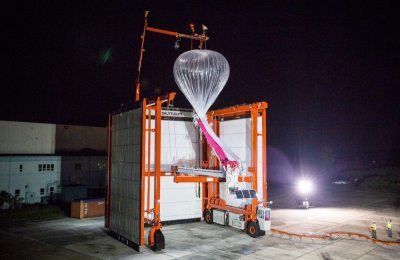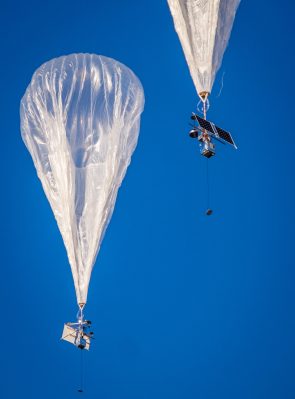Google Loon’s Internet Balloons Come Back To Earth After A Decade In The Stratosphere
After a journey of a decade, what started as Project Loon by Google is no more. Promoted as a way to bring communications to the most remote parts of the globe, it used gigantic, high-altitude balloons equipped with communication hardware for air to ground, as well as air to air communication, between individual balloons. Based around LTE technology, it would bring multiple megabit per second data links to both remote areas and disaster zones.
Seven years into its development, Loon became its own company (Loon LLC), and would provide communications to some areas of Kenya, in addition to Sri Lanka in 2015 and Puerto Rico in 2017 after Hurricane Maria. Three years later, in January of 2021, it was announced that Loon LLC would be shutting down operations. By that point it had become apparent that the technology would not be commercially viable, with alternatives including wired internet access having reduced the target market.
While the idea behind Loon sounds simple in theory, it turns out that it was more complicated than just floating up some weather balloon with LTE base stations strapped to them.
The (Ba)looney Part

The balloons that Loon used were manufactured by Raven Aerostar, from their Super Pressure balloon series. These are recommended by Raven for mission profiles such as scientific data collection, reconnaissance, remote communications and surveillance. Such super-pressure balloons (SPB) are aerostatic balloons which keep the volume of the balloon constant even when the external (ambient) pressure changes. This feature allows the balloon to stay at a fixed altitude for an extended duration, which was ideal for Loon’s mission profile in the stratosphere.
Made from 0.076 mm thin polyethylene, each balloon is 15 meters across and 12 meters tall when its two inner sections are inflated with helium and air respectively. To this balloon, a 10 kg payload box is attached which contains the LTE antennae, control system and the rest of the communication system, which appears to be the Ubiquity Rocket M2. Ground stations used the Rocket M5, with both the ground stations and the balloons using a custom patch antenna to facilitate the long-distance communication.
This package is completed with batteries and an array of solar cells, which allow the system to operate day and night for as long as the balloon retains its altitude. This tends to be a maximum of 100 to 150 days, after which the balloon is either gracefully deflated above a suitable landing zone, or in the case of a more rapid, unscheduled descent, captured by a parachute system that’s attached to the balloon. Loon’s goal was to re-use or recycle as much of each balloon and hardware as possible.
Mission Profile

While initially Loon balloons were launched manually, this process was eventually automated with an autolauncher system. After the balloon has been inflated and makes its way into the air, it faces the challenge of moving to where it’s needed. While Project Loon could have used dirigibles (‘blimps’) which would have including a method of propulsion, they instead chose to use the air currents in the atmosphere, rather than fight them.
To this end, Loon used NOAA-provided wind data for the stratosphere (starting between 10 and 20 km altitude). Each balloon would be directed to a layer where the air current was headed in the right direction. Over time this would allow the balloon to reach its approximate location. With no propulsion method, the only way for the balloon to stay within the area was to constantly change between wind layers by pumping air in or out of its air compartment to change its overall buoyancy.

Each balloon would communicate with ground stations, both for control and for the internet link which subscribers on the ground could then access via an LTE link. Communication between balloons within each reach was also a common feature, with subscriber’s internet link hopping a few balloon links before reaching a ground station. This inter-balloon communication was performed using radio frequency links, though laser-based optical communication was also being attempted over the past years.
After the mission ended, or at the end of the balloon’s lifespan, the balloon would be directed to an easy to reach area where its helium would be released into the atmosphere during which the balloon descended for recovery. On a number of occasions, however, balloons have crashed. Even with the parachute-based emergency system in place, it can still happen that the 10 kg payload plus balloon falls out of the sky.
However, even without those safety concerns, there was something else that was threatening to sink Loon LLC faster than a balloon with a helium leak: their financial balance sheet and increasingly desperate attempts to attract funding. As a commercial entity they would have to put into action a viable business plan that would enable them to somehow make money, if only for maintenance and further development.
Who Needs Floating LTE Towers?
As it turned out, large, fragile floating structures that are constantly subjected to the harsh conditions in the Earth’s stratosphere are quite expensive to maintain. As pointed out by Slate’s Future Tense on Loon’s demise, each balloon needed to be replaced approximately every five months at a cost of tens of thousands of dollars. With the target areas featuring mostly potential clients on the lower end of the income scale in that nation, subscriptions to the service were not going to cover the expenses.
There was also the issue that as a result of being solar-powered some parts of the globe were off-limits, reducing the potential markets. Finally, by being dependent on the right air currents in the stratosphere to navigate, any mistake or incorrect prediction there could lead to a balloon being taken many kilometers away from its intended location, cutting service for people in that area.
Despite having multiple ongoing trial projects by 2019, Loon as an independent entity was still reliant on its originating company Alphabet (formerly Google, now the parent company of Google). Having already burned through the money from an external investor, Loon was by that time trying to sustain a yearly loss of $100 million.
Between the advent of ground-based 4G and 5G towers in more and more areas and encroachment of wired internet, the possible market for Loon was rapidly shrinking. In addition, although space-based internet access had been an option for as long as Project Loon had been around, it had to that point been a remote threat, especially with the high cost and latency from primarily geosynchronous satellites. When SpaceX announced Starlink in 2015 and launched the first batch of Starlink satellites in 2018, Loon’s prospects began to look quite dire.
Lasers in Space

Unlike Loon’s balloons, Starlink satellites can be navigated to an exact orbital position in low Earth orbit (LEO), unaffected by weather and the atmosphere. Due to their close proximity to Earth, round-trip latency is minimal and bandwidth is expected to reach tens to hundreds of megabits using its Ku and Ka-band transceivers. SpaceX also has full vertical integration of Starlink satellite development and launch capability using Falcon 9 rockets today and conceivably hundreds of satellites being launched at once by Starship.
It’s not inconceivable that Starlink will be able to provide service to every square meter of the Earth’s surface within the next few years, at increasingly lower cost per satellite. With the lifespan of a single satellite being approximately 3-5 years based on what we know at this point, it’s reasonable to assume that they would be cheaper than Loon’s balloons over this time period.
As of writing, StarLink is being used by Beta testers primarily in the northern USA, providing people who are living in areas that are poorly serviced by existing wired and wireless (LTE) internet options suddenly with access to proper broadband internet connectivity. At the beginning of this year, SpaceX’s Transporter-1 mission also launched the first 10 StarLink satellites into a polar orbit which contain active laser-based inter-sat communication, allowing for multiple hops between satellites before reaching a ground station.
It’s the Business Plan, Silly
Perhaps more important than the costs was the altruistic angle of Loon: by focusing on providing LTE to impoverished areas first of all, it seems to have completely ignored the issue of a business needing income to finance itself. Their approach was to contract services to existing telecoms who would in turn sell to subscribers, but this never turned into a solid and reliable model. Much is yet unknown about how Starlink subscriptions will operate, but SpaceX decided to focus on first providing poorly connected North American citizens with the service, betting that they will be able to generate sufficient subscriber fees in this market.
As for the wind-down of Loon, a few assets from the project will find themselves absorbed into another Google X project: Taara. Taara involves none of the balloons or other flashy parts of Loon, instead taking mostly the newest technology that Loon was working on: the optical data links that would have increased the bandwidth between individual balloons. By using line of sight transceivers, this should theoretically enable remote areas to be connected with the internet and more without having to dig trenches to put in fiber.
While Loon’s story is at an end, it seems that with Taara the spirit of the project will live on. Here a major and so far unanswered question will remain whether Project Taara makes sense when Starlink exists. I’m however quite certain that within a matter of years we’ll have our answer here.
Post a Comment